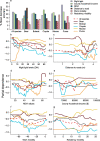iNaturalist insights illuminate COVID-19 effects on large mammals in urban centers
- PMID: 33424027
- PMCID: PMC7784545
- DOI: 10.1016/j.biocon.2021.108953
iNaturalist insights illuminate COVID-19 effects on large mammals in urban centers
Abstract
Restricted human activity during the COVID-19 pandemic raised global attention to the presence of wildlife in cities. Here, we analyzed iNaturalist observations of prominent wildlife species around North-American urban centers, before and during the COVID-19 pandemic outbreak. We suggest that the popular notion of 'wildlife reclaiming cities' may have been exaggerated. We found that while pumas ventured deeper into urban habitats during the COVID-19 pandemic, bears, bobcats, coyotes, and moose did not. Species differential behavioral responses may highlight their evolutionary history cohabiting human habitats. Nevertheless, our results highlight the importance of urban nature for people during the pandemic. Our insights could help manage urban wildlife, better plan greenspaces, and promote positive nature engagements.
Keywords: Anthropause; Culturomics; Human-nature interactions; Urban wildlife; iNaturalist.
© 2021 Elsevier Ltd. All rights reserved.
Conflict of interest statement
There is no conflict of interest to declare.
Figures

Similar articles
- Urban Compost Attracts Coyotes, Contains Toxins, and may Promote Disease in Urban-Adapted Wildlife.Ecohealth. 2016 Jun;13(2):285-92. doi: 10.1007/s10393-016-1105-0. Epub 2016 Apr 22.Ecohealth. 2016.PMID: 27106524
- What can we learn from wildlife sightings during the COVID-19 global shutdown?Ecosphere. 2020 Aug 6;11(8):e03215. doi: 10.1002/ecs2.3215. eCollection 2020 Aug.Ecosphere. 2020.PMID: 32834907Free PMC article.
- COVID-19 impacts on participation in large scale biodiversity-themed community science projects in the United States.Biol Conserv. 2021 Apr;256:109017. doi: 10.1016/j.biocon.2021.109017. Epub 2021 Mar 4.Biol Conserv. 2021.PMID: 36531527Free PMC article.
- Behavioural responses of wildlife to urban environments.Biol Rev Camb Philos Soc. 2013 Aug;88(3):537-49. doi: 10.1111/brv.12012. Epub 2012 Dec 24.Biol Rev Camb Philos Soc. 2013.PMID: 23279382Review.
- Wildlife in U.S. Cities: Managing Unwanted Animals.Animals (Basel). 2015 Nov 11;5(4):1092-113. doi: 10.3390/ani5040401.Animals (Basel). 2015.PMID: 26569317Free PMC article.Review.
Cited by
- Public perception of urban wildlife during a COVID-19 stay-at-home quarantine order in Chicago.Urban Ecosyst. 2023;26(1):127-140. doi: 10.1007/s11252-022-01284-x. Epub 2022 Sep 30.Urban Ecosyst. 2023.PMID: 36196074Free PMC article.
- Breeding in the pandemic: short-term lockdown restrictions in a European capital city did not alter the life-history traits of two urban adapters.Urban Ecosyst. 2022 Dec 14:1-11. doi: 10.1007/s11252-022-01309-5. Online ahead of print.Urban Ecosyst. 2022.PMID: 36532698Free PMC article.
- Mammal Roadkills in Lithuanian Urban Areas: A 15-Year Study.Animals (Basel). 2023 Oct 19;13(20):3272. doi: 10.3390/ani13203272.Animals (Basel). 2023.PMID: 37893996Free PMC article.
- iNaturalist is an open science resource for ecological genomics by enabling rapid and tractable records of initial observations of sequenced biological samples.Biol Lett. 2023 Oct;19(10):20230251. doi: 10.1098/rsbl.2023.0251. Epub 2023 Oct 4.Biol Lett. 2023.PMID: 37788713Free PMC article.
- Leveraging social media and other online data to study animal behavior.PLoS Biol. 2024 Aug 29;22(8):e3002793. doi: 10.1371/journal.pbio.3002793. eCollection 2024 Aug.PLoS Biol. 2024.PMID: 39208351Free PMC article.
References
- Alberti M. Eco-evolutionary dynamics in an urbanizing planet. Trends Ecol. Evol. 2015;30:114–126. - PubMed
- Altrudi S. Connecting to nature through tech? The case of the iNaturalist app. Convergence. 2020;1354856520933064
- Benson J.F., Mahoney P.J., Vickers T.W., Sikich J.A., Beier P., Riley S.P., Ernest H.B., Boyce W.M. Extinction vortex dynamics of top predators isolated by urbanization. Ecol. Appl. 2019;29 - PubMed
LinkOut - more resources
Full Text Sources
Other Literature Sources
